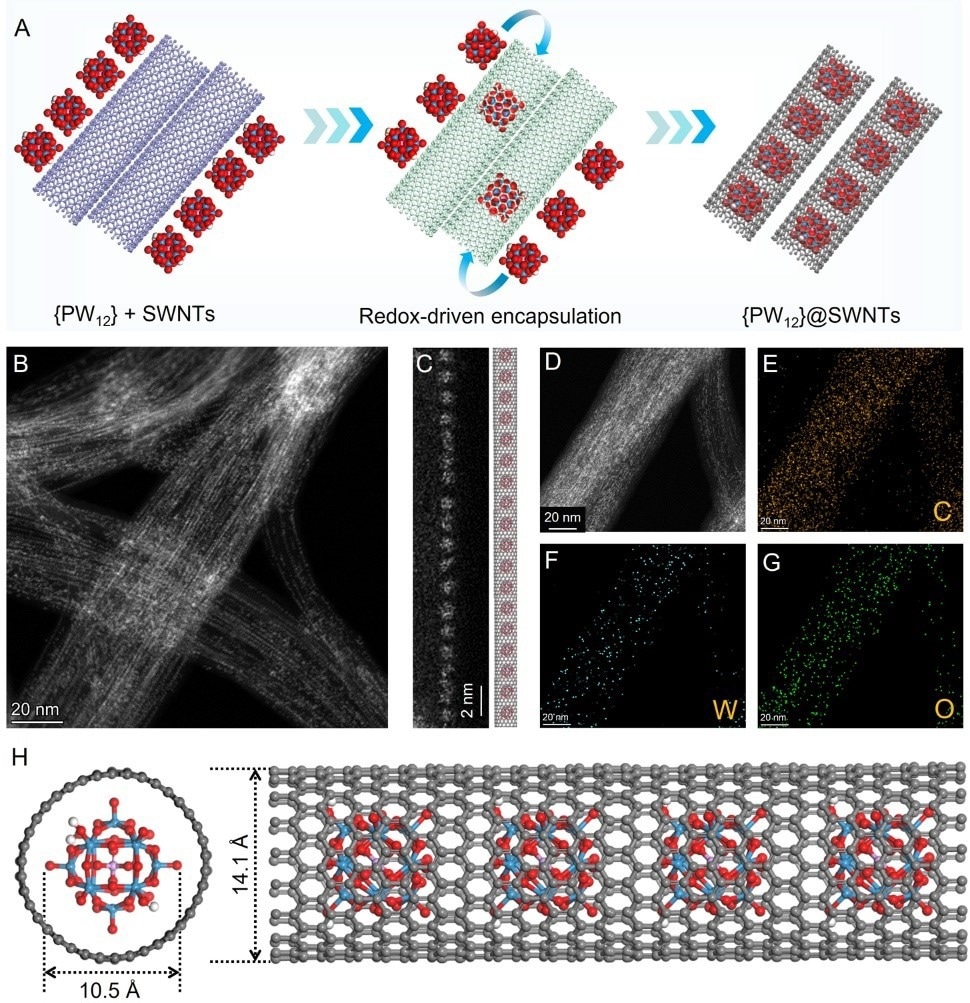Due to their excellent electrical conductivity, substantial theoretical surface area, and superior chemical stability, carbon nanotubes (CNTs) are seen to be the perfect electrochemical energy storage materials.

Schematic illustration and electron microscopy characterization of one-dimensional heterostructures of SWNT-confined polyoxometalate clusters. Image Credit: WANG Xiao
However, strong van der Waals pressures cause CNTs to cluster, which decreases the surface area that is electrochemically active. Due to their high length-to-diameter ratio, single-walled carbon nanotubes (SWNTs) face an even worse variant of this issue.
SWNTs (with a diameter of about 1.4 nm) have recently been encapsulated with polyoxometalate guest molecules to improve the electrochemical energy storage of CNTs, according to a recent study led by Dr. Xiao Wang from the Shenzhen Institute of Advanced Technology (SIAT) of the Chinese Academy of Sciences, Dr. Sheng Zhu from Shanxi University, and Prof. Yan Li from Peking University.
On June 8th, 2023, the study was published in Cell Reports Physical Science.
Polyoxometalate molecules create one-dimensional chainlike structures in the CNT cavity as a result of the confinement effect of CNTs. Such precise polyoxometalate@SWNT hybrids show promise as potential supercapacitor electrode material choices.
The reduction in the surface charge density of nanotubes caused by the electron transfer from CNTs to polyoxometalates decreases the van der Waals forces and inhibits aggregation. As a result, polyoxometalates-filled SWNTs exhibit a bigger electrochemically active area and a greater double-layer capacitance.
By enabling pseudocapacitance through reversible redox processes, polyoxometalate molecules can enhance the capacitive performance of polyoxometalate@SWNT hybrids. A notable improvement in the cycle stability of encapsulated polyoxometalates is made possible by the confinement effect of CNTs.
As a consequence, this one-dimensional hybrid material displays improved electrochemical energy storage capabilities, with a specific capacitance that is greater than that of pure SWNTs (172.2 farads per gram) and 328.6 farads per gram (10 millivolts per second). Additionally, after 10,000 cycles, the assembled supercapacitor has a capacity retention rate of 91.3%.
Our study offers valuable insights into the research on the confinement effect of CNTs, which holds immense potential for harnessing high-performance energy storage and conversion materials.
Dr Xiao Wang, Study Corresponding Author and Associate Professor, Shenzhen Institutes of Advanced Technology, Chinese Academy of Sciences
Journal Reference
Zhu, S., et al. (2023) One-dimensional heterostructures of polyoxometalate-encapsulated carbon nanotubes for enhanced capacitive energy storage. Cell Reports Physical Science. doi:10.1016/j.xcrp.2023.101446